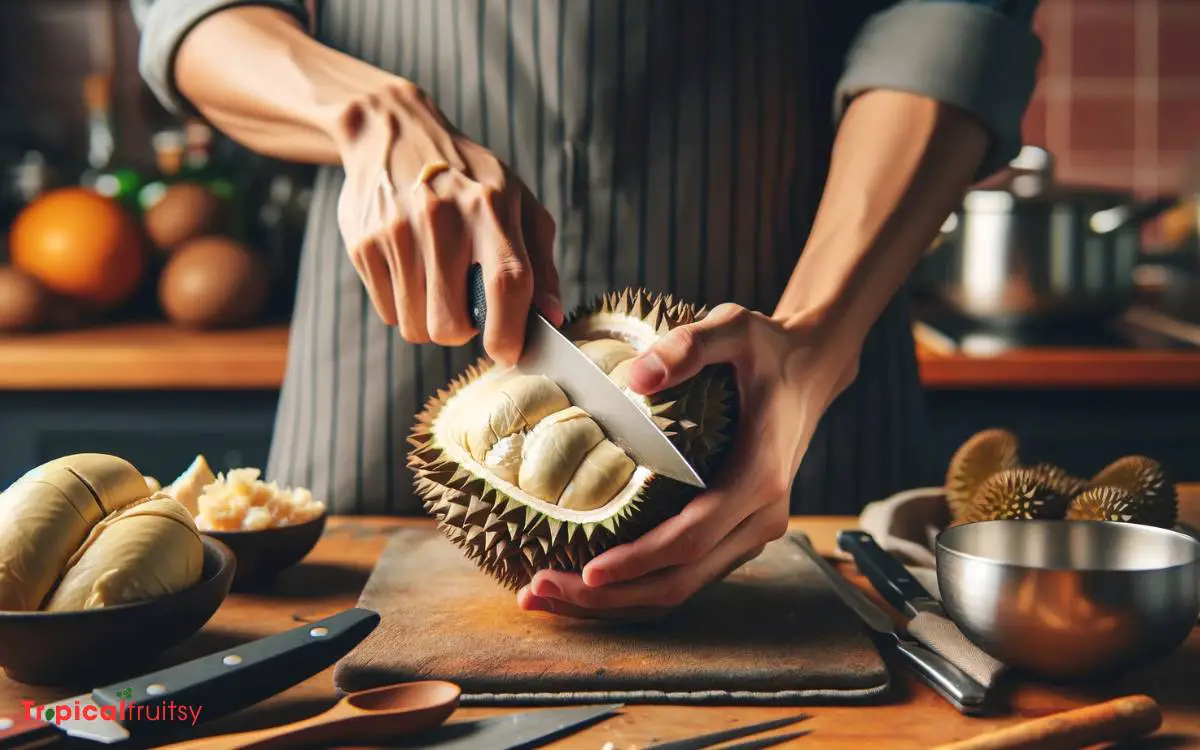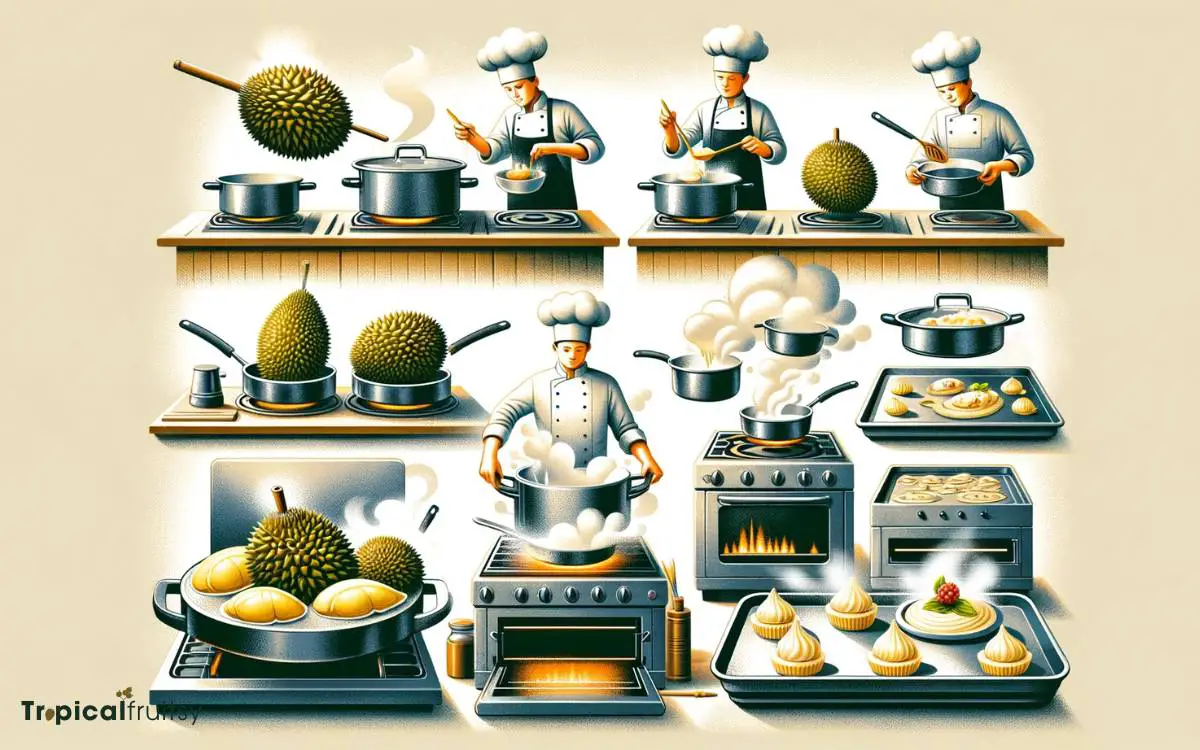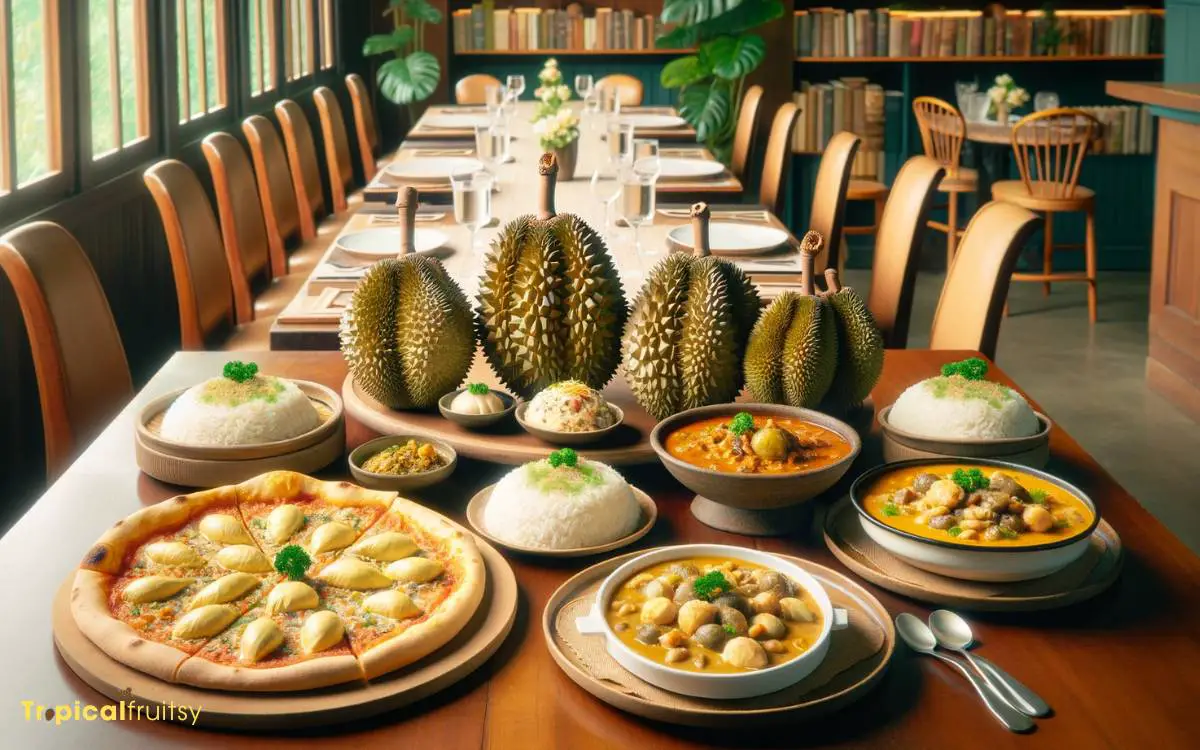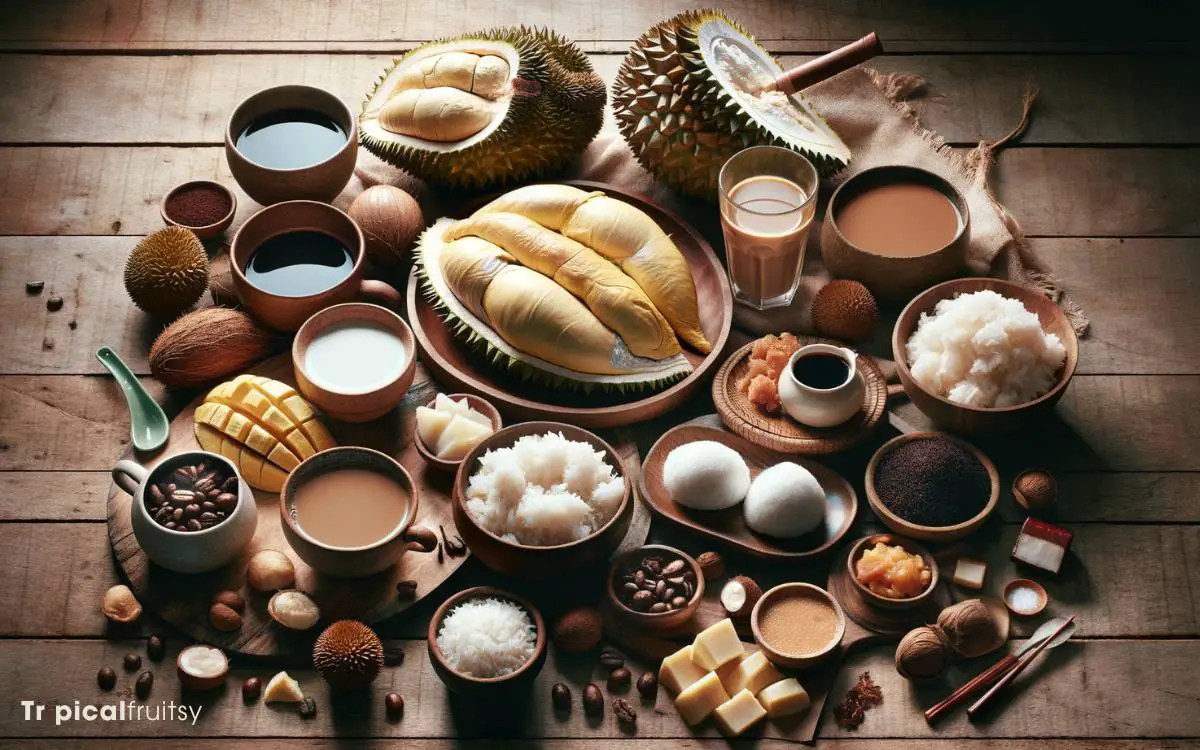How to Cook Durian Fruit? Easy Methods!
To cook durian fruit effectively, start by selecting a ripe durian with a strong aromatic scent, indicating its readiness for consumption.
Gently open the durian by making incisions along the seams of its husk and pry it open to reveal the soft flesh inside.
The edible part of the fruit can be eaten fresh or incorporated into various recipes, including cakes, ice cream, and savory dishes. Cooking durian can help to mellow its potent aroma and enhance its rich, custard-like texture.
The process of cooking durian involves careful handling and preparation:
Durian can be cooked in various ways, such as steaming, baking, or frying. Cooking methods are chosen based on the desired dish.
Discover the art of cooking durian, transforming its unique flavors into exquisite culinary creations.

Key Takeaway
Cooking Durian Fruit: Methods and Recipes
| Cooking Method | Description | Suggested Recipes |
|---|---|---|
| Fresh | Eaten raw, as is. | Durian fruit salad, fresh durian with sticky rice |
| Baking | Incorporated into batters for cakes or pastries. | Durian cake, durian puffs, durian crepes |
| Steaming | Often used for traditional desserts or to make pastes. | Durian steamed cake, durian mochi, durian sago dessert |
| Frying | Used for creating crispy durian snacks or chips. | Durian chips, fried durian balls |
| Simmering | Creating sauces or custards. | Durian custard, durian sauce for meat dishes |
Selecting the Right Durian

Selecting the ideal durian is crucially important, as it frequently determines the success of your culinary endeavors with this distinctive fruit.
To ensure a desirable outcome, one must engage in a thorough selection process. Begin by assessing the durian’s husk; it should appear fresh and firm, not dry or shriveled, indicating ripeness without over-maturity.
Next, scrutinize the stem, which should be stout and intact. A slight pressure on the husk should yield to your touch, a testament to the softness of the flesh within. Heed the aroma; the durian’s scent should be rich and pronounced without being overpowering.
Understanding Durian Varieties

Commonly overlooked, the variety of durian chosen can significantly influence the flavor and texture of your culinary creations. With over 30 recognized species and hundreds of cultivars, the diversity of durians is vast.
‘Musang King,’ known for its creamy consistency and bittersweet taste, reigns supreme in the durian world. ‘D24 Sultan’ offers a less intense but equally complex profile, suitable for those preferring a milder kick.
The ‘Red Prawn’ variety, as suggested by its name, boasts a soft, reddish flesh with a sweet, almost caramel-like finish.
Each variety carries its own unique set of sensory characteristics, from the custard-like richness of ‘Golden Phoenix’ to the more fibrous texture of ‘Kampung’ durians. Understanding these nuances is key to unlocking the full potential of durian in your kitchen.
Preparing the Fruit Safely

One crucial aspect of cooking with durian is the safe preparation of this thorny fruit, which involves proper handling techniques to prevent injury.
When approaching durian’s formidable armor, consider the following steps:
- Wear thick gloves or use a towel to grip the fruit securely, protecting your hands from its sharp spikes.
- Place the durian on a stable, flat surface to ensure it does not roll and cause an accident.
- Use a sharp knife with caution, slicing shallowly to find the natural seams of the husk.
- Gently pry the husk open along these lines with care, to avoid slipping and potential harm.
Removing the Durian Flesh

Upon breaching the husk, the next step in durian preparation is the careful extraction of the creamy pulp encased within the chambers of the fruit.
Donning gloves to shield against the spiky exterior, one should gently part the shell along its natural seams with a subtle twist.
The lobes of durian flesh, a rich custard-like substance with a potent aroma, will be revealed, nestled like precious gems in cotton-soft pockets.
Ease the sections out with a delicate hand, mindful to preserve their integrity. It’s a tactile experience, where the sense of touch is as crucial as sight to discern the ripest, most succulent pieces.
This golden bounty, once released, is ready for culinary transformation, from simple consumption to inclusion in more complex recipes.
Cooking Methods Explored

Exploration of the culinary versatility of durian begins with understanding the various methods by which this distinctive fruit can be cooked.
The robust flavors of durian lend themselves to a variety of cooking techniques, each of which can enhance its unique taste and texture in different ways:
- Baking: Transforming durian into cakes, pastries, or breads mellows its pungency and infuses baked goods with its creamy texture.
- Sautéing: Quickly frying durian flesh with a bit of oil can caramelize its natural sugars, creating a deeper flavor profile.
- Steaming: This gentle method preserves the fruit’s inherent moisture and softness, ideal for custards or traditional Southeast Asian desserts.
- Freezing: Although not a cooking method per se, freezing durian turns it into a rich, ice-cream-like treat, often enjoyed as a cold snack.
Each technique offers a pathway to appreciating durian’s complexity, inviting both novices and connoisseurs to savor its multifaceted character.
Sweet Durian Recipes

Durian’s rich and creamy texture makes it an exceptional ingredient for a variety of sweet recipes, from decadent confections to subtle, aromatic desserts.
Its unique flavor, akin to a blend of savory, sweet, and custard-like nuances, can transform traditional sweets into exotic delights.
One can craft a luxurious durian cheesecake, its velvety layers infused with the fruit’s distinctive taste, or opt for a simpler, yet equally indulgent durian mousse that captivates with its silky smoothness.
For a tropical twist, durian ice cream offers a refreshing escape, with every scoop carrying the essence of Southeast Asia.
And for those with a penchant for baking, incorporating durian into a sponge cake imbues it with a moist, tender crumb and a captivating aroma, creating a truly memorable dessert experience.
Savory Durian Delights

Moving beyond the realm of confection, the pungent and complex profile of durian fruit lends itself remarkably well to savory applications.
Exploring the culinary synergy of durian with umami-rich ingredients and aromatic spices can transform traditional dishes into an extraordinary experience.
We will investigate the nuanced cooking techniques that can tame the fruit’s boldness, making it an innovative addition to a discerning chef’s savory repertoire.
Durian Flavor Pairing
When incorporating durian into savory dishes, chefs must carefully consider complementary flavors that can harmonize with the fruit’s unique taste profile. The complexity of durian can be a delightful surprise when matched with the right ingredients.
Here’s a guide to flavor pairings that elevate the durian experience in savory culinary creations:
- Coconut Milk: The creaminess of coconut milk softens durian’s intensity, creating a rich, tropical base for curries and soups.
- Chilies: Spicy elements like chilies counterbalance durian’s sweetness and add depth to stir-fries and sambals.
- Seafood: Mild, fresh seafood complements durian’s savory aspects, particularly in Southeast Asian dishes like fish with durian sauce.
- Poultry: Chicken or duck provide a subtle backdrop that allows the nuanced flavors of durian to shine in complex stews and stuffings.
Cooking Methods Explored
Several cooking techniques can be employed to integrate durian into savory dishes, each method bringing out a different facet of the fruit’s complex flavor profile.
Stir-frying, for instance, allows the pungent aromas to mellow and marry with other ingredients, creating a cohesive taste.
When durian is steamed, its texture becomes more tender, complementing the delicate components of a savory custard or dumpling filling.
Roasting durian can enhance its inherent sweetness, adding a caramelized depth to rich meat stews or spicy curries.
These methods not only tame the fruit’s notorious aroma but also infuse the dishes with a unique savoriness that can intrigue the palate, offering a culinary bridge between traditional Asian cooking and modern gastronomic experimentation.
What to Do with Durian

Durian is a unique tropical fruit known for its distinctive smell and strong flavor.
If you have a durian and are wondering what to do with it, here are some ideas:
- Eat it Fresh: The most common way to enjoy durian is by eating it fresh. Cut open the spiky outer shell, remove the flesh, and enjoy the creamy, custard-like fruit. Some people love its strong aroma and flavor, while others find it less appealing.
- Make Durian Smoothies: Blend durian with other fruits like banana, mango, or coconut for a creamy and flavorful smoothie. You can also add yogurt or milk for a smoother texture.
- Durian Ice Cream: Durian is a popular flavor for ice cream and gelato in Southeast Asia. You can make durian ice cream at home using an ice cream maker or buy it from an Asian grocery store.
- Durian Desserts: Durian is used in various desserts, such as durian pancakes, durian custard, durian mochi, and durian tarts. These desserts often combine the unique flavor of durian with other sweet ingredients.
- Durian Candy: Some companies produce durian-flavored candies and snacks, which can be a less intense way to enjoy the fruit’s flavor.
- Durian in Baking: Incorporate durian into your baking by making durian cakes, muffins, or pastries. Durian’s creamy texture and strong flavor can add a unique twist to your baked goods.
- Durian in Savory Dishes: While durian is mostly used in sweet dishes, some cuisines incorporate it into savory recipes. You can try making durian curry, durian soup, or adding it to stir-fries for a surprising twist.
- Durian Jam or Spread: Make durian jam or spread by cooking down the fruit with sugar until it thickens. You can use it as a topping for toast, waffles, or pancakes.
- Freeze for Later: If you can’t consume the whole durian at once, you can freeze the flesh for future use. Store it in an airtight container or vacuum-sealed bags.
- Durian Milkshake: Blend durian with milk and sugar or honey to make a refreshing and indulgent durian milkshake.
- Durian in Smoothie Bowls: Top your smoothie bowls with chunks of durian for added texture and flavor.
- Durian Flavored Beverages: Use durian to flavor beverages like durian tea, durian coffee, or durian-infused water.
- Durian Candy: You can find durian-flavored candy and snacks in many Asian grocery stores. These can be a way to experience the flavor without dealing with the fresh fruit’s strong odor.
Remember that durian has a strong and polarizing aroma and taste, so it may not be for everyone. It’s best to start with small amounts and see if you enjoy its unique flavor before incorporating it into various dishes and recipes.
What to Eat with Durian

Durian is a unique and polarizing tropical fruit known for its strong aroma and distinctive flavor. If you’re planning to eat durian, it’s essential to choose complementary foods that can enhance your overall dining experience and balance the fruit’s strong taste and smell.
Here are some foods and beverages to consider eating with durian:
- Sticky Rice (Glutinous Rice): Pairing durian with sticky rice is a classic combination in Southeast Asia. The creamy and sweet durian complements the neutral, slightly sweet flavor of sticky rice. It’s often served with a drizzle of coconut cream or condensed milk.
- Coconut Milk: A serving of durian with a side of coconut milk or cream can mellow out the fruit’s intensity and add a rich, creamy texture.
- Mango: Fresh mango is a popular accompaniment to durian in many Thai and Malaysian desserts. The sweetness and tartness of mango contrast nicely with the durian’s richness.
- Pancakes or Crepes: Make durian pancakes or crepes and serve them with a dollop of whipped cream or vanilla ice cream. The combination of textures and flavors can be delightful.
- Ice Cream: Durian-flavored ice cream or gelato is a popular choice for those who want to enjoy the fruit’s taste in a frozen treat. You can also combine it with other ice cream flavors.
- Wafers or Cookies: Enjoy durian with plain wafers or cookies. The crunchiness of the wafers can provide a satisfying contrast to the creamy texture of the fruit.
- Chocolate: Dark chocolate, with its slight bitterness, can complement the sweetness of durian and provide an interesting flavor combination.
- Nuts: A small serving of nuts, such as almonds or cashews, can provide a textural contrast to the creamy durian.
- Tea: Sip on a cup of black or green tea to cleanse your palate between bites of durian. Tea can help refresh your taste buds.
- Citrus Fruits: Some people enjoy having a slice of citrus fruit like oranges or grapefruit to counterbalance durian’s richness and sweetness.
- Water: Keep a glass of water handy to help cleanse your palate and refresh your taste buds as you eat durian.
- Lemon or Lime: Squeezing a bit of lemon or lime juice over durian can add a refreshing tartness that cuts through the fruit’s richness.
- Mint Leaves: Garnish your durian dishes with fresh mint leaves for a burst of freshness and aroma.
Remember that durian’s strong smell and taste can be overpowering for some individuals, so it’s essential to approach it with an open mind. If you’re trying durian for the first time, start with a small amount and gradually increase it if you enjoy the flavor.
Additionally, be mindful of where you consume durian, as its distinctive odor may be off-putting to others in enclosed spaces.
Conclusion
In the tapestry of gastronomy, durian stands as a juxtaposition of formidable aroma against a rich, custardy essence.
Techniques ranging from steaming to baking unlock its potential, weaving sweet and savory threads into culinary masterpieces.
This tropical fruit, once enigmatic, is demystified through careful selection, preparation, and cooking, ultimately harmonizing its distinctive flavors with the global palate.
The exploration of durian in cuisine reflects a bold integration of tradition and innovation, an aromatic dance of complexity and delight.






